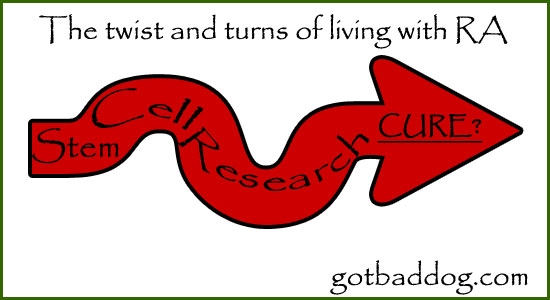It has been a month since I left off on my discussion on why Rheumatoid Arthritis should be renamed as Rheumatoid Autoimmune Disease and I apologize for that. Luckily, Tanya said I could take advantage of her RA Twist, so this is probably going to take a couple years to finish. Who knows, the world is supposed to end in December, so maybe it will never be completed.

Anyway, when I left off I was tying RAD together with South Park. As I mentioned earlier in the article about why RA should be called RAD, Tanya and I had just watched the movie ’Burzynski’ which is about Dr. Stanislaw Burzynski, a medical doctor that has seemed to have come up with a very effective method of combating even the most deadly of cancers. While one would hope that the medical community would be elated, the FDA started prosecuting the man because he was the sole patent holder on his discovery and big pharmaceutical companies would be losing a major cash cow. For me personally, the thing that upset me the most was not the bureaucratic bullshit, I expect that, but the fact that chemotherapy was the preferred method and that was a technology developed in the 1940’s! It made me wonder the likelihood of big pharmaceutical allowing a cure for RAD or any other killer disease. Then South Park came on.
As fate would have it, it was Season 7; Episode 2, Krazy Kripples and the subject was stem cell research. This made me wonder about whether or not stem cell research had even touched upon Rheumatoid Autoimmune Disease. It turns out they have.
Because it has taken me a month to write this, I have become more educated about the topic than when I watched that South Park episode last month. It seems that there are studies going on in the United States, but it seems to be limited to the worst of cases. I do not know if this is because it is stem cells and everyone jumps to the conclusion that stem cells equal abortions or what. What we have discovered is that there are treatments available in other countries. Call it coincidence or fate, but a week or two ago we happened to be at a meeting that included a gentleman that sets up medical vacations. Food for thought anyway.
I was going to go off on a different direction about how Obama used an RAD patient to help get elected, but has done nothing to help those with pre-existing conditions; or how all the Republican candidates are so anti-stem cell research that there is no way I would offer any of them an iota of support, but that will be a post for another day.
I will end this with a few observations I have made over the past month. First of all, the lack of awareness about RAD or RA in this country is terrible. A couple weeks ago I was flying home from Barcelona and happened to pick up a copy of The Daily Mail. As I thumbed through it I was pleasantly surprised to see that there was an article about Rheumatoid Arthritis and studies that had been done in England [as I recall, it was somewhere in Europe]. While I was not particularly pleased with what I read, I was impressed that RA was at least being talked about. I have never seen an article in any paper in the United States that mentioned it.
I also came across the blog of a gentleman who is married to a woman with RAD. I initially was attracted to his post discussing his first two wives. I could kind of relate in that while Tanya has RAD since before we became a couple, I have had the pleasure of enjoying some remission time with her. Hopefully, the move to CA will bring more of those back.
Since this guy has a lot in common with me, I decided to read further into his blog. In it I discovered symptoms that his wife is experiencing that are similar to new symptoms Tanya has mentioned. I read blogs like this, interact with other RAD patients, talk to Tanya, read letters from doctors and come up with nothing but questions. Sometimes I wonder if there really is anyone out there paying attention to RAD survivors. Tanya and I were talking over dinner about stem cell treatments that are available across our border. Cost ranged from $6,000 to $50,000 depending on the treatment required, with an average cost of $20,000. Would we pay $20,000 to rid Tanya of RAD? No question. She spends that much in six months with her current medications. But stop and think, do you really think the pharmaceutical companies are going to let a one-time $20,000 payment replace a $40,000 a year for the life of the patient?
Me neither.
